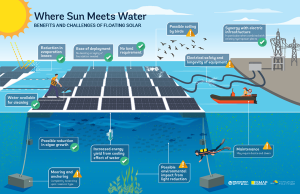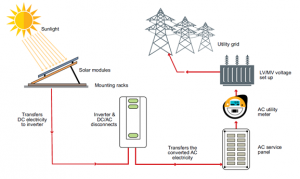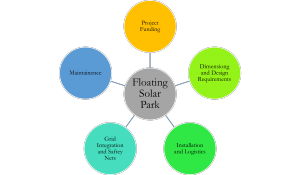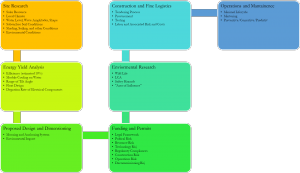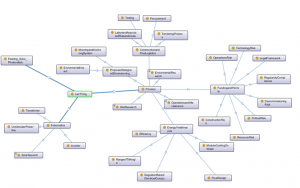Introduction
Figure 1: Overview of Floating Solar Photovoltaic Farm System
Floating Solar Photovoltaic (PV) Parks have provided a promising solution to providing electricity to remote islands in the Maldives. Because of the remote nature of the country and its a cluster of small islands, this system is an ideal product to build up the Maldives system of micro-grids and has been commercial developed in the Maldives since 2014. However, this product is both technically and logistically complex, therefore ontology modelling is a powerful tool to give designers and stakeholders and common frame of reference, and parametric modelling provides a valuable means to make this product more viable, and improve the economic and technical performance.
Figure 2: Schematics of Solar Photovoltaic System
Design Goals (Scope)
Conder the following issues as the engineering challenge: The demand of the island must be estimated, and the peak load accounted for. This in return leads to dimensioning and design requirements needed to make the peak demand which while likely be some combination of the existing diesel sets and the construction of the new solar floating park. The chosen design and dimensions of the new floating solar park lead directly to the needed logistics and resources needed for the project, in addition to possible maintenance over the lifetime. It easy to see how a multicriteria parametric optimization is needed to find a solution to each individual island and each microgrid.
For example, to provide an estimated 25% of the energy to a resort, a system can be concepted for one hectare that would provide approximately 10 MW and cost stakeholders initially 3 million usd. This also requires an extensive review of the initial build conditions.
Figure 3: Project Considerations
Design Optimization
Stakeholder and designers consider parameters for conditions, components, interrelationships, costs, risks in the system and lead to a better understand for optimum configuration of the floating solar park, in other works a balancing act of the project needs depicted below:
Figure 4: Product Design Aspects
Ontology Model
All of these parameters and design configurations, in addition to the most essential aspects of the product, are well captured in the ontology model.
Figure 5: Ontology Model for Floating PV
What is the purpose? The ontology models both the physical system, but more importantly the process for building such a system is modelled and clearly shows everything stakeholders need to consider and understand.
What is the scope? The application of this ontology reaches far beyond only the physical model of the floating solar photovoltaic farm, but also the conception of a complete project plan for building the so-called mini grid described earlier in the islands.
Who are the attended end users? This ontology serves to provide potential stakeholders, and their agents (possibly engineers, consults or project managers) with an extensive overview of what should be considered when designing and organizing the construction of floating solar photovoltaic in the Maldives.
What is the intended use? The ontology serves at the backbone for a multi-criteria parametric optimization to provide for a design solution that is a balancing act of several data driven parameter described earlier in this report. For example, the expected demand and load of the island in combination with the size and dimensions of the solution in combination with the efficiency of the system in combination with the construction costs etc. Through the ontology the shareholder should gain a view of ALL the essential elements to consider in the multi-criteria parametric optimization approach.
References
Bassiliades, N., Martinopoulos, G., & Kontopoulos, E. (2016). An Ontology-based Decision Support Tool for Optimizing Domestic Solar Hot Water System Selection. Journal of Cleaner Production.
Krötzch, M. (2013). A Discription Logic Primer. Oxford, United Kingdom: Department of Computer Science University of Oxford.
Nam Kim, K., & Pradityo Sukarso, A. (2020). Cooling Effect on the Floating Solar PV: Performance and Economic Analysis on the Case of West Java Province in Inodensia. Seoul, Korea: Korean University.
Noy, N., & McGuinness, D. (n.d.). Ontology Development 101: A Guide to Creating Your First Ontology. Stanford, California, United States: Stanford University.
Shumais, M., & Mohamed, I. (2019). Dimensions of Energy: Insecurity on Small Islands A Case Study of Maledives . Tokyo, Japan: Asian Development Bank Institute .
Solar Energy for Tropical Islands. (2015). Retrieved from Swimsol GmbH: https://www.irena.org/-/media/Files/IRENA/Agency/Events/2015/Sep/17/3FloatingsolarPVinvestmentcaseSwimsol151110.pdf?la=en&hash=0720DCD927AA3B5C6C3F8853A851DD98B26FEFDD
(2019). Where Sun Meets Water. Washington DC, Unites States of America: 2019 International Bank for Reconstruction and Development.
